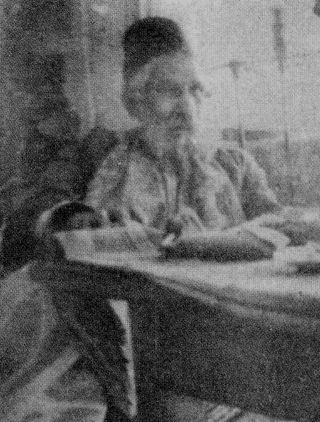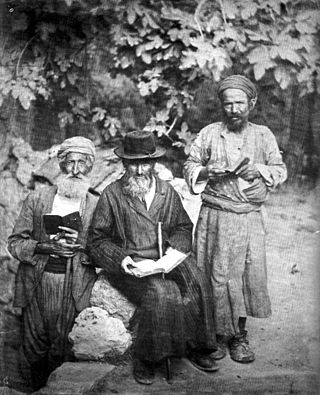Related Research Articles
Yom Tov ben Moshe Tzahalon,, also known as the Maharitz,, was a student of Moses di Trani and Moshe Alshich, and published a collection of responsa.
Chief Rabbi is a title given in several countries to the recognized religious leader of that country's Jewish community, or to a rabbinic leader appointed by the local secular authorities. Since 1911, through a capitulation by Ben-Zion Meir Hai Uziel, Israel has had two chief rabbis, one Ashkenazi and one Sephardi.
Israel ben Moses Najara was a prolific Jewish liturgical poet, preacher, Biblical commentator, kabbalist, and rabbi of Gaza.
Galante is a surname. Notable people with the surname include:

Eliyahu de Vidas was a 16th-century rabbi in Ottoman Palestine. He was primarily a disciple of Rabbis Moses ben Jacob Cordovero and also Isaac Luria. De Vidas is known for his expertise in the Kabbalah. He wrote Reshit Chochmah, or "The Beginning of Wisdom," a pietistic work that is still widely studied by Orthodox Jews today. Just as his teacher Rabbi Moses Cordovero created an ethical work according to kabbalistic principles in his Tomer Devorah, Rabbi de Vidas created an even more expansive work on the spiritual life with his Reishit Chochmah. This magnum opus is largely based on the Zohar, but also reflects a wide range of traditional sources. The author lived in Safed and Hebron, and was one of a group of prominent kabbalists living in Hebron during the late 16th and early 17th-century.
Hayyim ben Joseph Vital was a rabbi in Safed and the foremost disciple of Isaac Luria. He recorded much of his master's teachings. After Vital's death, his writings began to spread and led to a "powerful impact on various circles throughout the Jewish world."

Syrian Jews had predominantly two origins: those who inhabited Syria from early times and the Sephardim who fled to Syria after the expulsion of the Jews from Spain in 1492 CE. There were large Jewish communities in Aleppo, Damascus, and Qamishli for centuries. In the early 20th century, a large percentage of Syrian Jews immigrated to Palestine, the U.S. and Latin America. The largest Syrian-Jewish community is now located in Israel and is estimated to number 80,000.

Rabbi Hezekiah da Silva (1659–1698) was a Jewish author born in Livorno, Grand Duchy of Tuscany. He was the son-in-law of the dayan Mordechai Rafael Malachi.
Moses Hagiz was a Talmudic scholar, rabbi and writer born in Jerusalem during the time of the Old Yishuv. He was also one of the most prominent and influential Jewish leaders in 17th-century Amsterdam. During Hagiz's lifetime, there was an overall decline in rabbinic authority which was the result of migration and assimilation, and Hagiz devoted his career to restoring rabbinic authority. His most prominent talent was as a polemicist, and he campaigned ceaselessly against Jewish heresy in an attempt to unify the rabbinate.
Moses Galante was chief rabbi of Damascus during the late 18th century and early 19th century.
Abraham ben Mordecai Galante was an Italian kabbalist born in Rome at the beginning of the 16th century. Abraham, like his father Mordecai and his brother Moses of Safed, is represented by his contemporaries as a man of high character who led a holy life. Being wealthy, he erected a splendid mausoleum over the tomb of Simon ben Yoḥai at Meron, which is still admired.

Solomon Eliezer Alfandari, also known as the Saba Kadisha, was a distinguished rabbi, kabbalist and rosh yeshiva in his native home of Constantinople, and later served as Chief Rabbi of Damascus, Syria Vilayet, and Safed, Beirut Vilayet. He was known for his stringent interpretation of halakha and his uncompromising dedication to Orthodox Judaism.

Proto-Zionism is a term attributed to the ideas of a group of men deeply affected by the idea of modern nationalism spread in Europe in the 19th century as they sought to establish a Jewish homeland in the Land of Israel. The central activity of these men was between the years 1860 to 1874, before the Zionist movement established practical (1881) and political Zionism (1896). It is for this reason that they are called precursors of Zionism, or proto-Zionists.
Gabriel Esperanssa, also spelled Esperanza or Esperança, was a 17th-century rabbi at Safed. He was originally from Salonika, where he was a disciple of Daniel Estrumsa. He apparently assumed the name of a woman called Esperanssa, who adopted and educated him as an orphan.
Moses ben Mordecai Bassola, also known as Moses Bassola, Moshe Basola, Basilea, or Basila ; was born in 1480 in Pesaro, Italy, and died in 1560. He was a rabbi and a cabalist. His travel book has been published in English and modern Hebrew by Abraham David under the title In Zion and Jerusalem: The Itinerary of Rabbi Moses Basola.

The textile industry became an important feature of 16th-century Safed, Ottoman Galilee, following an influx of Jewish immigration in late 15th and early 16th centuries. Run as a Jewish monopoly, textile manufacturing became the community's main source of income. The industry declined toward the end of the century.
The Jaffe family is an Ashkenazi Jewish Rabbinic family originally from Dampierre, France. The family descends from the 12th century Tosafist, Elhanan Jaffe of Dampierre. Members of the family have produced numerous famous Rabbis, Court Jews, Talmudic scholars, Scientists, businessmen, academics and politicians, with members in Germany, Bohemia, Austria, Lithuania, Poland, Russia, Great Britain, Italy, Canada, Israel and the United States.
References
 This article incorporates text from a publication now in the public domain : Franco, M.; Kohler, Kaufmann; Broydé, Isaac; Deutsch, Gotthard (1903). "Galante". In Singer, Isidore; et al. (eds.). The Jewish Encyclopedia . Vol. 5. New York: Funk & Wagnalls. pp. 547–548.
This article incorporates text from a publication now in the public domain : Franco, M.; Kohler, Kaufmann; Broydé, Isaac; Deutsch, Gotthard (1903). "Galante". In Singer, Isidore; et al. (eds.). The Jewish Encyclopedia . Vol. 5. New York: Funk & Wagnalls. pp. 547–548.
- ↑ Shai Cabessa (2020). A Legacy of Torah: Insights/Parsha/Sphardi GeDoLim. p. 175. ISBN 978-1-60091-807-0.